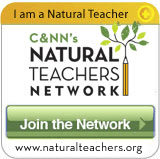1. Protect species from extinction: prevent habitat loss, create yard habitats, prevent the detrimental effects of introducing non-native, invasive species and pesticides into our natural environments. Here’s an example of the danger of habitat loss and butterfly migration in this article from Science Daily.
2. Spend more time outside. Connect with the land, the sea, and the sky using all of your senses. Let a summer monsoon soak you. Follow animal tracks in the snow. Go camping, go picnicking, read outside, star-gaze, explore nature with your toddler, go soak in a natural hot spring. The more time we connect with nature the more we will love and appreciate it, and the more we will work to protect its right to exist and thrive—so that we may do the same.
3. Start a family nature club. It’s easier and more rewarding than you might expect! Here’s a fantastic and free Family Nature Club toolkit from C&NN. A wonderful resource.
4. Protect the night sky from light pollution. Mankind has a long history with the stars and moon; navigation, cosmology, agricultural cycles and more. Not only does light pollution take away the beauty and knowledge gained of the stars, the Milky Way and deep sky objects for modern man, it wastes billions of dollars annually, consumes valuable natural resources, and pollutes our environment. Light pollution can seriously disrupt the natural rhythms and processes of plant and animals, threatening their survival. Here are 10 easy steps to help prevent light pollution.
5. Become involved in your community by participating in local environmental projects like neighborhood recycling, abandoned lot cleanups, community gardens and watershed restoration projects.
6. Follow blogs, or start your own, that share information about wildlife, natural areas, green living, green mommies, family nature activities, camping, creativity and nature, our oceans, spelunking—whatever you wish to learn more about. When it comes to nature, the list of possibilities are endless! Just type in a blog search of what you want to find.
7. Lend your professional services to a local environmental non-profit, pro bono. Or consider volunteering your time to teach youth about the environment, become a naturalist, man community booths, or lead outdoor art programs inspired by nature.
8. Be mindful of the connection between your daily choices and their effects on the environment. We can decide which plastics are more easily recyclable, or if we walk, or bicycle instead of driving to work. Show your love of the planet; know that every individual action or small deed adds up to a healthier environment.
9. Support your local nature centers, botanical parks, nature preserves and national parks. Visit often, buy annual passes. Fall in love with their beauty, wildlife, their restorative and inspiring affects on you.
10. Calculate and then reduce your carbon footprint at home and while traveling. Click here for the nature.org calculator.
11. Become an environmental steward to protect natural and cultural resources and nature areas for future generations. Get started by searching the internet “how to become an environmental steward (your state/city).”
This is just the tip of the (melting) iceberg regarding ways you can protect the planet. For 25 more ideas, read this short article listing, “25 Ways To Give Back: From Fur To Feathers.” The point is to get creative, and define what YOU value in the environment, then find ways to protect that gift from nature. Do you enjoy sitting on the porch at night and gazing up at the stars? Did an animal encounter speak to your soul? Do you yearn for camping under giant pines during the work week? Does the ocean move you to poetry?
Honor your nature connection.









